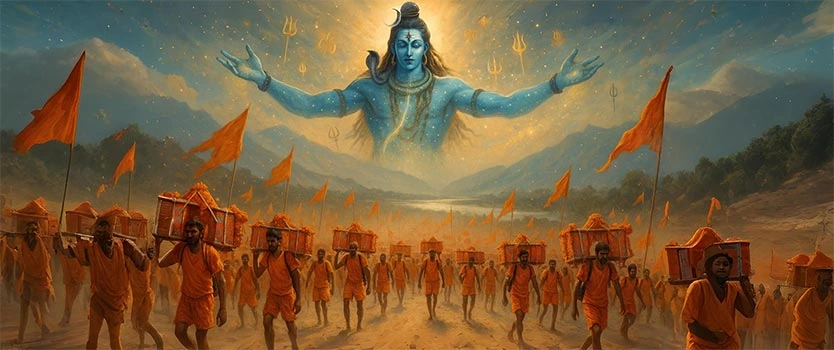
Sawan Maas, also known as Shravan month, is one of the most auspicious times in the Hindu calendar. Dedicated entirely to the worship of Lord Shiva, this holy month brings waves of devotion across India. One of the most remarkable expressions of this devotion is the Kavad Yatra, a spiritually intense pilgrimage undertaken by thousands of devotees.
In this blog, we explore the deep spiritual bond between Sawan Maas and the Kavad Yatra, the rituals involved, its astrological relevance, and how it transforms the lives of those who participate.
Kavad Yatra is a religious journey where devotees of Lord Shiva, known as Kanwariyas, carry holy water from the Ganga river in a bamboo structure called a Kavad. This water is then offered to Shiva temples, especially to a Shivlinga as an act of deep faith and gratitude.
The tradition finds its roots in ancient Hindu texts and is often linked to mythological tales where even divine beings performed acts of devotion towards Shiva. Today, this yatra is most commonly observed in regions like Haridwar, Gangotri, Gaumukh, Sultanganj, and Deoghar (Baidyanath Dham), among others.
Sawan is considered the favorite month of Lord Shiva. According to Puranic stories, during this month, Lord Shiva consumed the deadly poison halahala that emerged from the Samudra Manthan (churning of the ocean). To cool him down, devotees pour sacred Ganga Jal on his Shivlinga.
Thus, Kavad Yatra performed in Sawan Maas becomes especially powerful. Carrying Ganga water on foot and offering it to Shiva is seen as an act of surrender and penance. Many believe it purifies the soul, removes sins, and brings spiritual blessings, prosperity, and peace.
Also Read: Sawan 2025: Auspicious Dates, Rituals and Vrat Vidhi
The journey of a Kanwariya is not just physical—it is deeply spiritual and disciplined. There are specific rituals and rules that every devotee follows:
These rituals aren’t mere traditions—they are part of a self-cleansing and spiritually elevating process.
Kavad Yatra is not just about reaching a destination; it's a symbolic representation of life itself. The weight of the Kavad symbolizes the burdens we carry, and walking barefoot signifies our connection to dharma and humility. The hardship taken up willingly represents penance for past karmas and a step toward inner transformation.
Each step in the Yatra is a reminder of the soul's journey through life—sometimes painful, often testing, but always divine when taken with the right spirit.
In 2025, Sawan Maas begins on Friday, July 11 and ends on Friday, August 9. This makes the month especially significant for Shiva devotees.
Kanwariyas usually start their journey in the early days of Sawan, culminating it by pouring the Ganga Jal on a Monday or an auspicious Tithi. The most favorable Nakshatra or lunar phase for beginning the Kavad Yatra will be shared by local temples or astrologers as the month approaches.
Also Read: What are the Effects of Shravan on Zodiac Signs?
First-time Kanwariyas should prepare both mentally and physically. Here are some essential tips:
Most importantly, carry a heart full of faith, humility, and willingness to serve.
Sawan Maas is not only spiritually significant but astrologically powerful. During this period, the Moon, the ruling planet of the mind, is in a deeply spiritual position. Monday, governed by the Moon, becomes ideal for Shiva worship.
Devotees may consult their birth chart before performing the Yatra. Especially beneficial are:
Worshipping Lord Shiva during this month, particularly through Kavad Yatra, is believed to pacify negative planetary effects and bring mental clarity.
Kavad Yatra during Sawan is not merely a pilgrimage—it is a moving meditation, a living prayer. Each step, each chant, and each drop of sweat carries the devotee closer to Lord Shiva’s grace.
For those who participate, it becomes a deeply transforming journey, merging devotion with discipline and connecting the outer path to the inner self.
If you're considering taking up the Yatra, consult your astrologer to align your spiritual efforts with cosmic timing. And remember—this path is not about perfection, but sincerity.
It is considered an act of penance and devotion toward Lord Shiva, believed to purify the soul and bring blessings.
Yes, traditionally devotees walk barefoot as a sign of humility and devotion. However, some carry footwear for medical reasons.
Yes, although it is more common among men, many women also undertake the Yatra with full faith and discipline.
The distance varies based on the starting point. Common routes like Sultanganj to Deoghar are around 105 km.
It is not compulsory, but it is beneficial to align the Yatra with favorable planetary timings for spiritual and karmic gain.
Author : Krishna